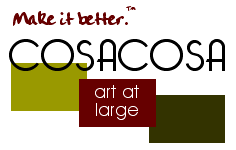



The powerful, instinctive desire to give meaning and identity to a place connects the individual and the community through art. Our prehistoric ancestors incised, carved, and painted vivid images on rocks and in the dark recesses of caves from France to Zimbabwe — our earliest example of a public art. Similarly, our longing for spaces where we can gather and celebrate the mysteries of nature is rooted in the world’s ancient sites, as in Stonehenge in England, the vast Angkor Wat observatory complex in Cambodia, and the ruins at Chichén Itzá in Mexico.
While today we can only speculate about the cave paintings and monumental sites, and what they meant to the people who created them, we are nonetheless fundamentally connected over centuries by the human impulse to make our mark, find our place, and reflect upon our society.
Public art is part of our public history, part of our evolving culture, and part of our collective memory. As artists share their inner vision with the outside world, they give shape to our dreams. One thinks of the unique and unforgettable Guell Park by Antonio Gaudi in Barcelona, Simon Rodia’s Watts Towers in Los Angeles, and Nek Chand’s Rock Garden in Chandigarh, India.
Public art combines the artists’ imagination, creativity and skill with the knowledge, experience and commitment of communities; and public participation reinforces community values, identity and reciprocity. The bioanthropologist Ellen Dissanayeke reflects, “Everyone agrees on the importance to our personal lives of such human verities as the giving, finding, and keeping of love, the inescapability of moral choice, sacrifice, human suffering and redemption, longing and loss, life and death. These are what life is, and they are the primary subject matter of the arts, today as well as in the past.” The particular challenge of public art is how to promote authentic community engagement and reflection, and at the same time create a meaningful framework for the most creative artistic outcome.
COSACOSA’s Telling Time, Telling Place project and its resulting North Philadelphia Memorial Healing Garden reflect and influence the spirit of a special place – the “genius loci.” While ultimately optimistic in approach, the project emerges from the raw truths of urban life and the potent desire for community spiritual and physical health, transformation and revitalization.
This brings to mind the movement by a cadre of artists to help heal and reinvigorate New Orleans following the human and economic devastation left by Hurricane Katrina in 2005. Artist Mel Chin conceived a Safehouse and Fundred Dollar Bill Project as part of his Operation Paydirt, a creative action to call attention to the lead polluted soil of New Orleans. Chin brought together artists, educators, scientists, health care providers, and planners to work together to deal with the lead pollution “that places thousands of children at risk for severe learning disabilities and behavioral problems, including violent crime.”
The sculptural icon for this project is a Safehouse, a formerly abandoned house located in one of New Orleans' flood-wrecked neighborhoods. The Safehouse looks like a vault from the outside. Its interior holds a diagram that maps local lead concentrations in red. It looks eerily like a pulsing heart. Posted on the walls of the Safehouse are hundreds of Fundred Dollar Bills, original drawings by schoolchildren that create a “currency” for the project. The goal is to collect 3 million of these, created by children across the country, and deliver $300 million Fundred Dollars to Congress in Washington D.C., asking for an “even exchange” in funds and services to address continuing lead-related health issues in post-disaster New Orleans. By creating Fundred Dollars, children nationwide will take part in this project and support the rebuilding of New Orleans.
Telling Time, Telling Place and Safehouse share the ethos of their respective places; that is to say that they are fundamentally unique to their time and place. Public art can serve as a symbol or sign of our times, create or enhance a sense of place, embody social beliefs or personal values, or engage public participation. To my mind, the very best place-making projects accomplish all of these ambitions.
Penny Balkin Bach is the Executive Director of the Fairmount Park Art Association. She is the author of Public Art in Philadelphia, editor of New•Land•Marks: Public Art, Community, and the Meaning of Place, and has written numerous essays on public art.